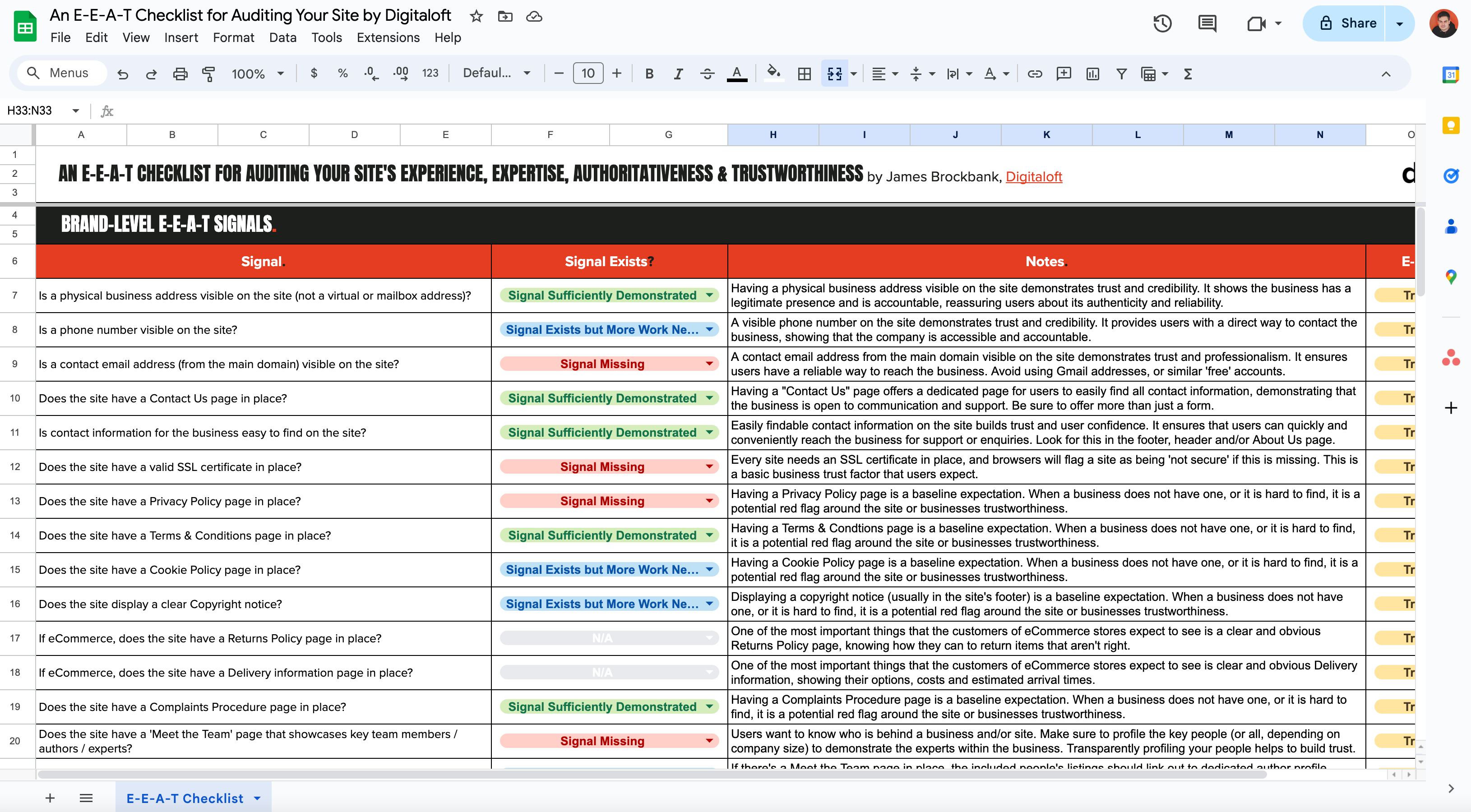
There’s no escaping the importance of building and demonstrating E-E-A-T if you want to see SEO success in 2024 and beyond, but many struggle with knowing where to start, especially given that it’s more of a concept than anything else.
E-E-A-T (Experience, Expertise, Authoritativeness & Trustworthiness) are important considerations when Google’s Quality Raters give a PQ rating (PageQuality) to pages they’re giving feedback on, but they’re not a direct ranking factor in the same way a lot of other things in SEO are.
In fact, Google tells us that “Raters assess how well content fulfils a search request, and evaluate the quality of results based on the expertise, authoritativeness and trustworthiness of the content. These ratings do not directly impact ranking, but they do help us to benchmark the quality of our results and make sure these meet a high bar all around the world.”
And while there are 121 references to E-E-A-T in Google’s Quality Rater Guidelines, these don’t give SEOs and site owners a blueprint of how to actually go about making sure their site demonstrates a high, or ideally very high, level of E-E-A-T.
That’s why I developed a 89-point E-E-A-T checklist that you can use to audit how your site, its content and its authors demonstrate experience, expertise, authoritativeness and trustworthiness.
Introducing the E-E-A-T Checklist
Over the last few years, I’ve spent countless hours studying not just the QRGs but what sites that are incredibly successful at SEO demonstrate in terms of the signals that align with the things indicated in these guidelines.
And whilst we absolutely must remember that E-E-A-T is a concept and guidelines that Quality Raters use, rather than a confirmed list of signals that an algorithm uses, that doesn’t mean we can’t consider the type of signals that demonstrate experience, expertise, authoritativeness and trustworthiness.
I’m a big believer that these are the things that align with building a business’s reputation, and I’ve found when talking about E-E-A-T with SEOs and site owners that this is a bit easier to understand as a concept. It’s not too hard to understand why it’s impossible to give a ‘reputation score’ to a business. There are so many variables for different businesses that it just wouldn’t work. Think of E-E-A-T like this. We can’t give scores because what’s important to one business in a particular industry is of much less importance to a different business in another industry.
More than anything, this E-E-A-T checklist is intended to get you thinking about how your site, your content and your authors demonstrate the signals that Google’s QRGs could be looking for when evaluating sites.
Work through the checklist, audit your site and put together a plan to improve the areas you’re currently not doing, or could be doing better at.
E-E-A-T will only become more important over the coming months and years, at least from an SEO perspective. But it shouldn’t really just be about SEO. Users expect these things from businesses and websites, and that’s a good enough reason to me to double down on demonstrating these signals.

How to Use the Checklist
The E-E-A-T audit checklist is broken down into three sections:
- Brand-level E-E-A-T signals
- Content-level E-E-A-T signals
- Author-level E-E-A-T signals
Brand-level signals apply to the website and/or business publishing content. Think of these as sitewide signals.
Content-level signals apply to a specific page, post or piece of content on a site. Think of these as page-level signals.
Author-level signals apply to the author of an individual page, post or piece of content. Think of these as signals that are specific to the person who produced the content.
Within each section, you’ll find the individual signals, a dropdown to assign one of four possible E-E-A-T signal ratings, a notes section to give further information on understanding the signal, and the E-E-A-T concept that the signal relates to.
To use the checklist effectively, you have two options for the content-level and author-level signals, remembering that these are unique to each piece of content and each author.
- Use these checklist sections for each individual piece of content and each author, working through the site against these items. This can be effective if you want to get really granular, although some items will apply to all pieces of content on the site.
- Use these checklist sections against a sample of 5 to 10 pieces of content and a handful of authors. This can be a quick way to get a really good understanding of the trends across these issues and opportunities. Usually, if there are areas for improvement across a sample set, they’ll exist across far more of the site, too.
Audit your site by looking for and/or analysing each signal, assigning one of the statuses on the dropdowns.
When you’ve finished, you’ll get a total of the signals assigned to each rating (except N/A, as those can be ignored).

This should give you a good starting point as to how sufficiently you’re currently demonstrating E-E-A-T.
Understanding the Four Possible E-E-A-T Signal Ratings
As you work through the checklist, you’ll need to assign one of four possible ratings to each signal:
- Signal sufficiently demonstrated
- Signal exists, but more work needed
- Signal missing
- N/A
Here’s how to go about assigning these ratings and the things you need to consider:
Signal Sufficiently Demonstrated
If your site demonstrates the signal, and you’re confident that it does so well, mark it as ‘Signal Sufficiently Demonstrated.’
In a lot of cases, you just need to remember that you’ll need to keep demonstrating this signal. Whilst some (such as creating standalone author pages), sufficiently demonstrating a signal is a one-off task, with only period reviews needed, others will need consistent work to be considered to meet this level.
As an example, earning links and mentions from the press. This isn’t a tickbox for a one-off press feature. Far from it. It’s about consistently earning these on a regular basis.
Signal Exists, but More Work Needed
Often, you’ll find that a signal does exist on your site, but that it can be improved.
If this is the case, mark it as ‘Signal Exists, but More Work Needed.’
If your site already has standalone author pages, but these are based on a basic WordPress template that only shows the author’s name and the posts they’ve published on the site, for example, there’s work needed to improve these and sufficiently demonstrate the signal.
Signal Missing
If a signal isn’t demonstrated or in place on your site, mark it as ‘Signal Missing.’
These should then be your main focus areas for improving your site’s E-E-A-T and your highest priority action items.
When a signal is missing, you should plan how to demonstrate it or work it into your strategy. These are usually the quickest wins you can make in terms of improving your site’s likely E-E-A-T level, so you’ll want to look at these before looking at those that exist but where more work is needed, in most cases.
For example, if your site doesn’t have standalone author pages, mark this signal as missing.
N/A
Some of the signals might not be relevant to your site or business. If so, mark these as ‘N/A’.
For example, some of the signals are only relevant to eCommerce stores. You don’t need to worry about demonstrating these when they don’t apply to you.
FAQs
Have questions about the checklist? Maybe you’ll find the answers here… if not, feel free to drop me a message or email.
This checklist was put together based on experience and insights gained from both Google’s Quality Rater Guidelines and sites that are doing well on the SERPs.
The signals included in the checklist are either factors referenced in the QRGs (for example, About Us pages) or my opinion on how experience, expertise, authoritativeness and trust can be demonstrated.
There is no such thing as an E-E-A-T Score, and it would be impossible to calculate one. For this reason, I chose not to calculate a score from this checklist. Consider each signal carefully, determine which apply to you, and make sure you’re demonstrating these.
No, you shouldn’t set out to demonstrate every single one of the signals included in the checklist. That’s not the idea.
Rather, demonstrate as many as you can out of those which are relevant to your business and site.
For various reasons, some signals included in the checklist either won’t be relevant or can’t be demonstrated, for various reasons.
But remember, there isn’t an E-E-A-T score, and what it takes to demonstrate the four concepts for one business is different to another.
Use this checklist as a starting point for considering what makes your users trust your site, content and people.
E-E-A-T isn’t a ranking factor in the way things like links or great content are. And we shouldn’t try to think about it like that.
Think about E-E-A-T like your reputation. It can have an indirect impact on your sites rankings, of course it can, but it’s about aligning with the things that ensure your site, content and people hold and are demonstrating experience and expertise, are considered an authority in the space and are trustworthy.
There’s no guarantee that improving these signals will improve your rankings, because E-E-A-T isn’t a direct ranking factor.
But that doesn’t mean you shouldn’t improve these things. Far from it.
These signals align with what users expect from a site in order to trust it. And whilst they’re not direct ranking factors, we do know that Google most likely feeds sites that demonstrate a high and very high level of E-E-A-T into its machine learning systems.
Let’s just say you want to demonstrate E-E-A-T. And when you think about it like your reputation, it’s easier to understand why it’s not something you can measure or assign a score to.
